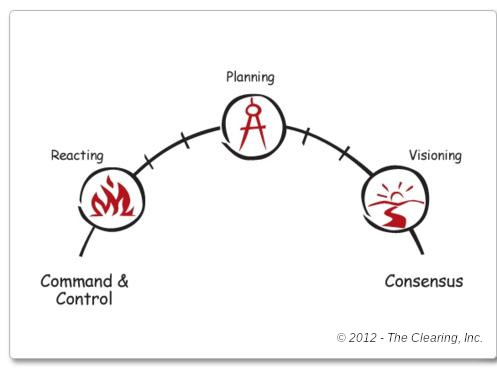Leaders tend to have a “default” style of decision-making. Some are more comfortable making Command and Control decisions, while others prefer Collaboration. The most effective are skilled at matching the decision process to each situation.
Every leader can master the four primary decision-making processes, deciding for each situation which process is most effective.
-
Command and Control – Use this leadership style when the bullets start flying, when the situation is urgent, and the stakes are high. Someone has to take Command and Control to evacuate a building on fire.
-
Informed Command and Control – This leadership style works well in situations that are still urgent, but where the stakes are lower, such as when a company requires a meeting venue and reservations must be made within hours.
- Limited Consensus – Use this style for low-stakes strategic planning, such as choosing between competing but similar health insurance plans.
- CONSENSUS – Put this in your pocket for high stakes strategic planning and visioning, like creating a five-year plan for taking a new company into the marketplace.
On one end of the LEADERSHIP SPECTRUM, Command and Control is preferred when time is short and any decision made fast is better than a perfect one made too late. Outside of combat or physical emergency, using Command and Control should be a rare occurrence.
CONSENSUS is on the other end of the LEADERSHIP SPECTRUM. This process is most appropriate for strategic planning, and exploring innovations and breakthrough ideas. Ineffective leaders overuse CONSENSUS decision-making, relying on it even when situations cry out for rapid Command and Control decisions.
IN ACTION
Condition yourself to assess, upon entering into any meeting, which leadership style is best for that particular situation. Good leaders recognize they have a preferred style but are disciplined in mastering and applying the full range of styles as warranted by the circumstances they face.
SO WHAT?
Poor leaders tend to overuse their default style and end up making decisions inappropriately or not at all, to the detriment of the organization.

